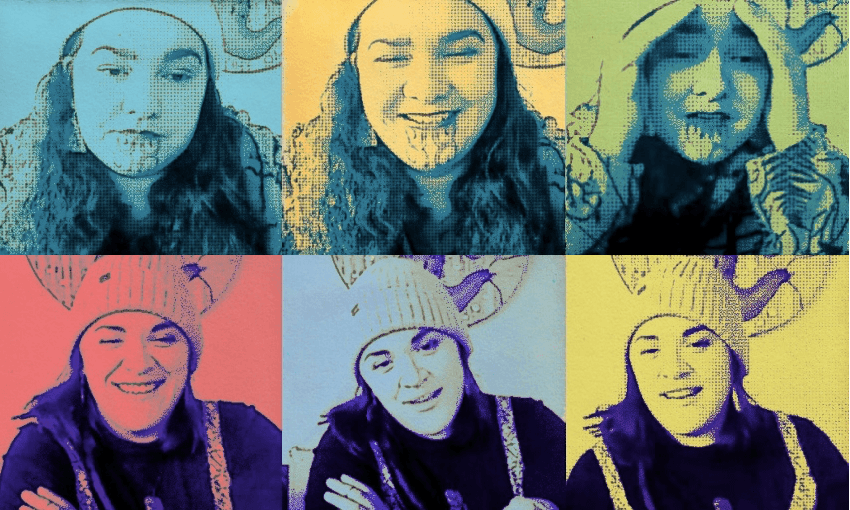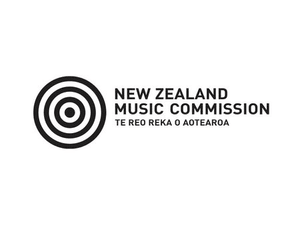There aren’t many women composing for taonga puoro. In fact, there aren’t many people like Te Kahureremoa Taumata and Khali Phillips-Barbara at all.
Earlier in the year I was lucky enough to attend the Te Hā annual Māori writers’ hui, where I met (among many inspirational kaituhi Māori) a poet and musician named Ladyfruit. Mere minutes after we met she announced “me inoi tātou” (let us pray) in the middle of afternoon tea, and thinking we were about to have karakia for the challenging weekend ahead, I took her hand and bowed my head. She began to pray, quite dramatically, for a husband. I know it’s bad to giggle during karakia, but I think the atua would have understood.
Ladyfruit is Te Kahureremoa Taumata (Ngāti Kahungunu, Ngāti Tūwharetoa), or Kahu, a Wellington-based musician who sings, raps and plays guitar, a storyteller and taonga puoro composer and a māmā of two. On the one hand a playful pop imp with a guitar in her hand and on the other, a conduit for old, old music and knowledge.
When we talk she is racing to complete a Covid response funding application for Creative NZ before the deadline. Taumata and her best friend Khali Phillips-Barbara (Ngāti Porou, Ngāti Uepohatu) make up the Te Whare Tapere performance duo Timotimo, who share storytelling, waiata Māori, kapa haka, taonga puoro, poi and even ngā karetao puppetry. Their busiest performance time is around the middle of the year, but all of their bookings have been cancelled.
“Matariki and Mahuru Māori are our high season in terms of performing and doing storytelling, and there’s nothing there but we still want to be able to give things out to our people.”
They’re applying for funding to take elements of their live storytelling and waiata to create online content for whānau.
“We saw a lot of really dry content come out in response to Covid,” she giggles. “Everyone at home thought they could do the lives. So rather than rushing into content, we want to really think about what kids and adults want to watch together. We’re really passionate about not being a passive consumer, and making it whānau screen time. With Aunty Kahu and Aunty Khali!”
Last year Taumata was one of 12 people chosen for a three-week indigenous songwriter residency at the Banff Centre for Arts and Creativity in Alberta, Canada. It was her first big overseas trip. The successful applicants just needed to fund their plane tickets, and everything else was taken care of.
“You were given space and time to create anything you wanted to,” she says, acknowledging what a rare opportunity that is for a mum.
Initially the application was for both her and Phillips-Barbara, and the pair planned to work on an album of oriori (lullabies), but through an administrative issue (“I don’t even remember what happened,” she confesses), it was awarded only to Taumata.
“I had to readjust my whole way of being there without my best mate. But going there by myself actually forced me to rework and just see what I could come up with.”
She describes the Banff centre as “Hogwarts for creatives”.
“It’s like its own little village, it has restaurants and gyms. We had our own huts and there were lots of different artists there as mentors. I collaborated with quite a few different indigenous artists on their pieces, but for myself I had this lone wolf kind of vibe. It’s such a rare thing for me to have space to myself so I really had to hold a boundary so I could sit and work with myself, which was really exciting.”
Taumata describes her favourite mentors, aboriginal Australian musicians Daniel and David Wilfred: “They were cool, they were like our tīpuna, hard out. They hadn’t been speaking English that long, three years maybe, so their English language was simple. It stripped away so much bullshit about how we communicate, they would say the most profound things. Daniel would say things like, ‘My song is old, but it travels far’ and I would be like, ‘yesss’.”
Taumata documented her trip almost hour-by-hour on her Instagram story. She was thrilled and terrified; overwhelmed by beauty and inspiration, and homesick. Watching the creative journey of an artist play out in real time was genuinely moving, especially one whose practice involves responding to the whenua. Here at home we watched as she made a lot of art, played puoro alone in her hut, and composed songs and poems to the mountains.
“The mountains in Banff around the centre are full of rose quartz, and it was just a really inspiring landscape to create in. The mountains legit sang. So I ended up making mountain songs mostly. I felt really inspired to play my puoro there. And I made this one random Ladyfruit jam.
“Everyone there had pegged me as this puoro witch,” she exclaims. “We had the opportunity to record in the studio and when I bowled up on the day of recording, I had all of these puoro tracks to record and some mountain songs, and then I had one random rap song and they were like, ‘whaaat?’. I came up with it the night before and it was kind of inspired by the water and it ended up being this cool funky jam about Ladyfruit, which is the name of my alter ego.”
In the past she says she considered Te Kahureremoa Taumata to be the low-key musician and Ladyfruit the sassy pop singer-songwriter, but the distinction is slowly blurring.
“I’m really interested in transitioning out of being known as Ladyfruit. It was inspired by Beyoncé and Sasha Fierce. I really felt that because when I first started making music eight years ago, I had crippling stage fright. I couldn’t control my voice on stage. I’ve done some super-awkward performances in front of my heroes like Che Fu,” she laughs. “So I created Ladyfruit as a bit of armour to put on, and since then I have kept Te Kahureremoa for taonga puoro and waiata Māori. Ladyfruit is me wanting to be rebellious and not be put into a waiata Māori box. I just also want to explore pop music; I think it’s a really powerful way to pass on information.”
She explains: “I feel like I so naturally fit into waiata Māori, Māori music, whatever that is, however we define that, that also being Ladyfruit felt like a bit of a rebellious mood – for a kura kaupapa, Māori boarding school kid to go and make weird, creepy pop music.”
The boarding school in question is St Joseph’s, the prestigious Māori girls’ college responsible for producing songbirds like Hinewehi Mohi, Moana Maniapoto and Maisey Rika, not to mention great leaders like Whina Cooper and Kāterina Mataira. The school is world famous for its choir.
She admits unconsciously she may have been rebelling against the school’s clean-cut image, but says the school itself was a great place to learn to be rebellious, simply because it fosters young women to stand strong in their Māoritanga against a world that will wilfully misunderstand them.
“St Joe’s prepared me really well to be a wahine Māori. It also gives me this need to break out and be a weirdo sometimes. Being a weirdo at boarding school makes you really, really seem like a weirdo.”
Khali Phillips-Barbara is also a St Joseph’s alumna, but seven years younger than Taumata, so the didn’t pair meet until they were both working in the education programme at Te Papa.
Like Taumata, Phillips-Barbara comes from a musical family and has been composing waiata all her life. “When I got to Te Papa I think I realised I was a storyteller. I cannot read out loud, it’s not my favourite thing to do. But kids want stories and I would grab some puppets and it kind of grew from there. And then one day we were like, ‘hey, I don’t want to do this for Te Papa any more, we should just do it for ourselves’.”
Many popular musicians still holding down main jobs will be envious to know Timotimo is Taumata and Phillips-Barbara’s main source of income, pre-Covid at least. The pair are sought after for performances, workshops and kids’ events, but also for corporate gigs for large commercial firms (“we don’t do any hōhonu stuff for them, we just let them see the playful side,” Taumata tells me). Nearly all of their bookings are from word of mouth.
“People book us ’cause they see us once, and that’s been our main means of promotion. People ask us for a card and we’re like, ‘eh?’” Phillips-Barbara says.
“And thus far it’s been bloody working,” Taumata adds.
But they’re only ‘touring’ online spaces for now, and are having the necessary discussions about what is and isn’t appropriate to put out there. “We ain’t about to put any iwi-specific things online, I think we keep things generalised for a wider audience. We’ve already chosen some stories we want to put online,” Taumata says.
“There’s this huge drought around really good, quality taonga puoro content. And if you do find stuff, it’s mostly tāne.”
Phillips-Barbara agrees: “There’s a drought of nourishing kōrero, especially about our atua wāhine. We want to open up the forgotten rights, for us as Māori, to reimagine our pūrakau. Our pūrakau are flowing; they’re fluid.”
“I’ll give you an example,” says Taumata, and begins to tell the story of Hineraukatauri, goddess of the pūtōrino flute, who took the form of a moth.
“This is one we retell, it’s different when you hear a tāne tell it.”
(Ed’s note: apologies for the audio quality)
“That version, how we tell it, and depending on who we’re telling it to, the first part can be stretched out to Raukatauri just living her best life,” Taumata tells me.
“The imagery of her transforming into a moth and taking refuge in her favourite instrument and filling that with music is a beautiful lesson for wāhine, that we can take time to build our āhuru around ourselves and fill that space until we’re ready to peek our heads out and look at the moon, and sing again. But when tāne tell that story, there’s no context for her, she’s just singing a song and she’s lonely and needs a man. And he hears her and he’s like, ‘she sounds lonely, I better go fill up her cocoon!’”
It’s a timely reminder that Māori art forms have also passed through colonisation, and that wāhine Māori have more agency than they might think when it comes to traditional narratives.
“These atua whakapapa to us, they’re in our blood. Of course we can reimagine them, they’re ours to embody,” Phillips-Barbara says. “Another part of that [Hineraukatauri] story is, in nature, the female bag moth needs to eat the male bag moth in order to give birth.”
Taumata adds, laughing: “If we’ve got an audience full of aunties, we tell that version.”

